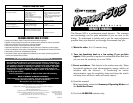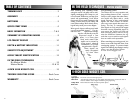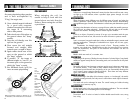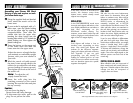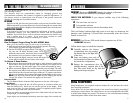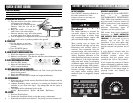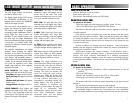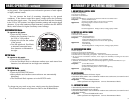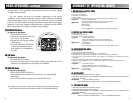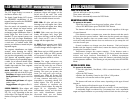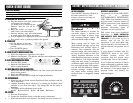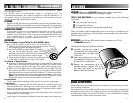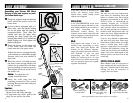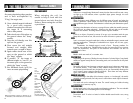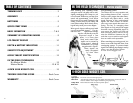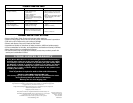
7
TURN THE DETECTOR ON
Click the left knob to the on position.
Three tones will sound.
The detector automatically enters the DISC Mode.
NO-MOTION ALL-METAL MODE
To operate in this mode:
• Hold the search coil over the ground surface, about 1/2 inch.
• Press ALL-METAL,then press GROUND TRAC Button.
The detector will emit only one monotone sound, regardless of the type
of metal detected.
If the detector emits a constant tone, retune the detector with the search
coil just above the ground surface. Make sure that the ground area chosen
for tuning the detector does not contain metal; if unsure, switch into DISC
mode and verify that the detector does not emit tones as you sweep the coil
over the chosen spot.
Ground conditions can change over short distances. Until you become
familiar with the detector’s volume level, retune the detector periodically by
pressing the GroundTrac button.
Temperature changes also require retuning. If the detector emits a
constant tone, or loses sensitivity, retune. If you have stored the detector
indoors and move outdoors immediately to a different temperature
environment and begin detecting, retune the detector periodically until the
coil temperature stabilizes. This retuning is only necessary in the ALL-METAL
Mode.
MOTION ALL-METAL Mode
To operate in this mode:
• Turn the right knob, Disc/Notch, 100% counterclockwise, to the off
position.
• Press the DISC button.
• Reduce the Sensitivity Control to the 2:00 or 3:00 position.
• Sweep the coil over the surface of the ground.
The detector will emit one of three tones, depending on the type of metal
detected.
The top display will indicate the type of metal targeted.
The bottom display will indicate the depth, in inches, of coin-sized objects.
A worthwhile target is evidenced by a consistent tone, and a repeatable
target and depth indication as you sweep back and forth over the same spot
BASIC OPERATION
more next page
10
LCD TARGET DISPLAY
-Motion modes only
READING THE DISPLAY
The LCD Target Display is accurate in
the Motion Modes only.
The Liquid Crystal Display (LCD) shows
the PROBABLE identification of the
targeted metal, as well as the PROBABLE
depth of the target, in inches.
Pass the search coil repeatedly over a
target, and observe the target readout.
The detector will register a repeated,
unchanging target identification when a
buried target has been located and
identified. If, upon repeated passes over
the same spot, the target identification
reads inconsistently, the target is probably
a trash item, or oxidized metal. With
practice, you will learn to unearth only the
repeatable signals.
The segment identifications are highly
accurate, when detecting the objects
described on the label. For example, if
you pass the coil repeatedly over a nickel,
your detector will repeatedly register a
nickel. However, if you repeatedly register
a nickel, for an unknown buried object,
you could be detecting some other
metallic object with the same magnetic
signature as a nickel.
GOLD TARGETS Gold objects will
register on the left side of the LCD scale.
Gold flakes will register under Iron/Foil
Small gold items will register under Pull
Tab.
Medium-sized gold items will register
under S-caps.
Large gold items will register as Zinc 1¢.
SILVER TARGETS: Silver objects will
register to the right of the scale, under
25¢, 50¢, or $1, depending on the size
of the object. The larger the object, the
farther to the right it will register.
IRON/FOIL: All sizes of iron and
aluminum objects will register on the
far-left side of the scale. This could
indicate a worthless item such as a nail,
or a more valuable historic iron relic.
PULL TAB: All older pull tabs from
beverage cans will register here. Most
newer pull tabs will register here. Many
gold rings will also register here.
S-CAPS: Older screw caps from glass
bottles will register here. Large gold
rings, like a class ring, could also register
here. Some non-U.S. coins of recent
vintage will also register here.
1¢ ZINC: Newer pennies (post-1982)
will register here. Many non-U.S. coins
of recent vintage will also register here.
10¢: Dimes and pre-1982 pennies will
register here. Older, pre-1982, pennies
are composed of copper, which has a
metallic signature similar to a dime.
Caution: The target indications are
visual references. Many other types of
metal can fall under any one of these
categories. You will experience a
trash-to-treasure ratio when treasure
hunting. The more you practice, the
lower you will push your trash-to-
treasure ratio. While the Pioneer 505
will eliminate or indicate the presence
of most common trash items, it is
impossible to accurately classify ALL
buried objects. The LCD provides a
visual reference to minimize the
detection of trash objects. By using the
target ID in conjunction with
discrimination control and the three-
tone audio identification system
(discussed later), you can further
reduce the trash-to-treasure ratio.



